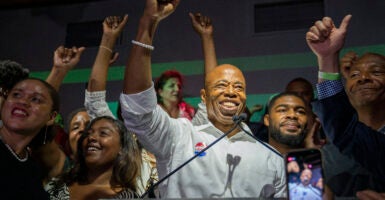Ranked choice voting, in which voters rank candidates on a ballot rather than choose one, may harm black and Native American voters disproportionately, according to a new study by a Princeton University professor.
Minority candidates also may be undercut by ranked choice voting, said Nolan McCarty, a professor of politics and public affairs at Princeton’s School of Public and International Affairs and vice dean for academic assessment.
McCarty did the study for the Center for Election Confidence, previously known as the Lawyers Democracy Fund, which says it is the first academic study of the subject by a mainstream, nonpartisan source.
The study determined that with ranked choice voting, African American voters in New York City and Alaska Natives were most likely to have their votes disqualified in later rounds of counting at a higher rate than white voters, diminishing minorities’ electoral influence.
“Ballot exhaustion” is a term used by election watchers to describe a ballot that is discarded if a voter ranks only candidates who end up being eliminated from contention.
“It’s not deliberate. This wasn’t a rationale by the advocates for adopting ranked choice voting,” McCarty told The Daily Signal. “But there was an indifference by advocates to the history that runoffs were adopted in some southern states to reduce the influence of minority votes.”
>>> Related: 9 Things You Should Know About Ranked Choice Voting
The study comes ahead of Jan. 23, which the advocacy group Rank the Vote dubs RCV Day as a way to promote ranked choice voting nationally.
Ranked choice voting has become among the most contentious battles in election law in recent years, as several state legislatures either consider it or ban it.
As of the 2022 elections, the system was used in a total of 62 jurisdictions, including statewide in Alaska and Maine as well as New York City, Minneapolis, San Francisco, and Cambridge, Massachusetts, according to the Ranked Choice Voting Resource Center.
Seven local jurisdictions in California, more than 20 jurisdictions in Utah, five cities in Minnesota, four cities in Colorado, three jurisdictions in Massachusetts, two cities in Michigan, and two jurisdictions in New Mexico use the system for local elections, according to Rank the Vote.
Kansas and Wyoming use ranked choice voting in presidential primary elections. In several states, only one city uses the method.
Neither Rank the Vote nor the Ranked Choice Voting Resource Center responded to The Daily Signal’s inquiries for this report.
Proponents contend that ranked choice voting, often called RCV, will decrease political polarization by producing less extreme candidates in party primaries, give independent candidates a better chance in a general election, and prevent these independent candidates from becoming spoilers.
“But even if RCV elections achieve the touted features, RCV raises important questions about the impact on minority and disadvantaged voters and their opportunities for electoral representation and effective influence in election outcomes,” McCarty’s study notes.
“First, RCV elections, by design, are more majoritarian than plurality elections. Indeed, a common argument is that they provide a way to get the benefits of a majority-runoff system without holding separate elections,” the study continues. “Whereas minority candidates have some chance of winning plurality elections when votes are closely divided between majority-group candidates, RCV works to reduce those opportunities especially in the presence of racially or ethnically polarized voting.”
The Princeton professor’s study examined Democrats’ primary in New York City as well as Alaska’s statewide elections.
“I find that exhaustion rates in the NYC Democratic primaries for executive office were higher in precincts with high concentrations of minority (black, Asian, and Hispanic) primary voters than they were in predominantly white precincts,” McCarty says in the report.
He adds: “In the executive office primaries, the proportion of voters ranking only a single candidate was generally higher in minority precincts.”
The study found similar results in Alaska’s statewide races.
“The results in Alaska largely confirm those of NYC for heavily Alaskan Native precincts,” the study says. “Their exhaustion rates were higher in all statewide races and for state legislative races except in the case of the U.S. House election which featured a co-ethnic winner.”
Lisa Dixon, executive director of the Center for Election Confidence, said the research provides data behind anecdotal evidence.
Supporters of ranked choice voting disregard the anecdotal evidence of negative effects on minority and disadvantaged voters, she said.
“Proponents of RCV often disregard the anecdotal evidence that it negatively affects minority and disadvantaged voters,” Dixon said in a public statement. “Importantly, Dr. McCarty’s research documents these negative impacts with quantitative data, demonstrating that further adoption of RCV risks undermining voter confidence in election fairness.”
In New York City, the NAACP and the New York City Council’s Black, Latino, and Asian Caucus opposed the adoption of ranked choice voting.
FairVote, a group that advocates for RCV noted that exit polls showed voters from all groups found it simple. A 2021 Rank the Vote New York Edison Research poll found more than 80% of black, Latino and Asian voters found RCV to be “simple to complete.” In Alaska, a 2022 poll by the pro-RCV Alaskans for Better Elections reported that at least 80% of Alaska Native, black, Latino, and Asian/Hawaiian voters said the system was “simple.”
“Both jurisdictions also elected historically racially diverse officials, including a majority-minority council and the second Black mayor in NYC and the first Alaska Native congressperson in Alaska,” FairVote spokesman Will Mantel told The Daily Signal in a statement. “We’ve also seen the first majority-minority city councils elected in RCV contests in Salt Lake City, Minneapolis, and St. Paul”.
Whether voters found the system easy to use, and what communities are most impacted by ballot exhaustion are two separate matters. Though voters who understand the system may be less likely to have ballot exhaustion.
California Gov. Gavin Newsom, a Democrat, vetoed a bill providing for ranked choice voting. Conversely, red states such as Kansas, Utah, and Wyoming warmed to the method.
However, on balance, conservative-leaning groups such as the Honest Elections Project overwhelmingly have opposed ranked choice voting and supporters have been dominated by left-leaning groups such as the Campaign Legal Center and FairVote.
“I’m baffled by the clear-cut partisan divide,” McCarty said in an interview with The Daily Signal about Republicans’ opposition to and Democrats’ support for ranked choice voting. He added:
If someone came to me 10 years ago and asked me which party is likely to support ranked choice voting, I would have guessed the Republicans. The Libertarian Party is the largest third party in the nation, and could mostly likely pull votes from Republican candidates. But it hasn’t broken out that way.
I think that’s in part because white progressive groups supported the system and it has made Republicans more suspicious. Though ranked choice voting could help or hurt Republicans as much as it could help or hurt Democrats.
This story was updated to include information from FairVote.
Have an opinion about this article? To sound off, please email [email protected], and we’ll consider publishing your edited remarks in our regular “We Hear You” feature. Remember to include the URL or headline of the article plus your name and town and/or state.































